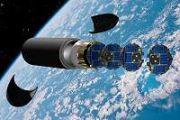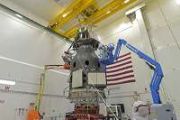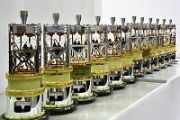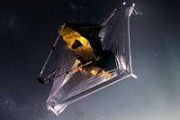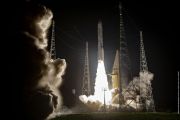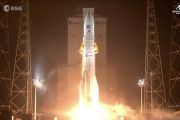
Copernical Team
AI maps icebergs 10,000 times faster than humans

In a groundbreaking development, researchers from the University of Leeds have unveiled a neural network that can swiftly and accurately chart the expanse of large Antarctic icebergs in satellite images, accomplishing the task in a mere 0.01 seconds. This novel approach is in stark contrast to the laborious and time-consuming manual efforts needed previously.
Final three for ESA's next medium science mission
 The space science community has narrowed down the shortlist for ESA's next 'medium' mission to three finalists: M-Matisse, Plasma Observatory and Theseus. Following further study, one will be selected for implementation as the newest addition to ESA's space science mission fleet.
Medium (or 'M-class') missions are a key component of ESA's Science Programme that enable Europe to answer impo
The space science community has narrowed down the shortlist for ESA's next 'medium' mission to three finalists: M-Matisse, Plasma Observatory and Theseus. Following further study, one will be selected for implementation as the newest addition to ESA's space science mission fleet.
Medium (or 'M-class') missions are a key component of ESA's Science Programme that enable Europe to answer impo New Test Case Enables Satellite-to-Ground 5G Connectivity, Boosting Rural and Remote Access
 Keysight Technologies, Inc. (NYSE: KEYS), a prominent player in the field of testing and measurement equipment, has marked a significant milestone by validating the first protocol conformance test case for the 3rd Generation Partnership Project (3GPP) Release 17 (Rel-17) standards, specifically focusing on non-terrestrial networks (NTNs) using narrowband Internet of Things (NB-IoT) technology. T
Keysight Technologies, Inc. (NYSE: KEYS), a prominent player in the field of testing and measurement equipment, has marked a significant milestone by validating the first protocol conformance test case for the 3rd Generation Partnership Project (3GPP) Release 17 (Rel-17) standards, specifically focusing on non-terrestrial networks (NTNs) using narrowband Internet of Things (NB-IoT) technology. T Major $200M gift propels scientific research in the search for life beyond earth
 The SETI Institute, a non-profit scientific research organization, has announced a philanthropic gift of $200m from the estate of Franklin Antonio, a visionary supporter and catalyst of the work of the SETI Institute for more than 12 years. Co-founder of communications chip company, Qualcomm, Antonio passed away on May 13, 2022, leaving behind an extraordinary legacy to enable breakthrough scien
The SETI Institute, a non-profit scientific research organization, has announced a philanthropic gift of $200m from the estate of Franklin Antonio, a visionary supporter and catalyst of the work of the SETI Institute for more than 12 years. Co-founder of communications chip company, Qualcomm, Antonio passed away on May 13, 2022, leaving behind an extraordinary legacy to enable breakthrough scien Webb findings support long-proposed process of planet formation
 Scientists using NASA's James Webb Space Telescope just made a breakthrough discovery in revealing how planets are made. By observing water vapor in protoplanetary disks, Webb confirmed a physical process involving the drifting of ice-coated solids from the outer regions of the disk into the rocky-planet zone.
Theories have long proposed that icy pebbles forming in the cold, outer regions
Scientists using NASA's James Webb Space Telescope just made a breakthrough discovery in revealing how planets are made. By observing water vapor in protoplanetary disks, Webb confirmed a physical process involving the drifting of ice-coated solids from the outer regions of the disk into the rocky-planet zone.
Theories have long proposed that icy pebbles forming in the cold, outer regions Australian-Backed SPIDER Payload to Fly on Firefly's 2026 Lunar Mission
 Firefly Aerospace, Inc., a key player in the space transportation sector, has struck a new deal with Fleet Space Technologies to deploy an Australian-developed seismic research payload to the Moon's far side. This mission, slated for 2026, will feature Fleet's Seismic Payload for Interplanetary Discovery, Exploration, and Research (SPIDER) aboard Firefly's Blue Ghost lander.
This collabora
Firefly Aerospace, Inc., a key player in the space transportation sector, has struck a new deal with Fleet Space Technologies to deploy an Australian-developed seismic research payload to the Moon's far side. This mission, slated for 2026, will feature Fleet's Seismic Payload for Interplanetary Discovery, Exploration, and Research (SPIDER) aboard Firefly's Blue Ghost lander.
This collabora Cerberus Fossae Identified as Primary Source of Marsquakes
 The Mars InSight mission, since its inception, has shed light on the seismic vibrancy of the Red Planet. The mission's deployment of a seismic station has led to the recording of 98 low-frequency seismic events. Despite the challenges posed by the singular nature of the data collection point and the often ambiguous seismic signals, a significant stride in martian seismology has been made, pinpoi
The Mars InSight mission, since its inception, has shed light on the seismic vibrancy of the Red Planet. The mission's deployment of a seismic station has led to the recording of 98 low-frequency seismic events. Despite the challenges posed by the singular nature of the data collection point and the often ambiguous seismic signals, a significant stride in martian seismology has been made, pinpoi Leidos Enhances ISS Capabilities with New xPWD Water System
 Leidos (NYSE:LDOS), a renowned leader in science and technology, has reached a significant milestone by deploying its innovative Exploration Potable Water Dispenser (xPWD) to the International Space Station (ISS). This deployment marks a substantial achievement in the domain of space exploration technology, providing astronauts with an advanced system for accessing potable water-a vital resource
Leidos (NYSE:LDOS), a renowned leader in science and technology, has reached a significant milestone by deploying its innovative Exploration Potable Water Dispenser (xPWD) to the International Space Station (ISS). This deployment marks a substantial achievement in the domain of space exploration technology, providing astronauts with an advanced system for accessing potable water-a vital resource NSF funds annual solicitation seeking physical science research leveraging the ISS National Lab
 For the ninth consecutive year, the U.S. National Science Foundation (NSF) is funding a solicitation that seeks proposals leveraging the International Space Station (ISS) National Laboratory for research in the physical science area of transport phenomena.
NSF will provide up to $3.6 million for multiple projects to utilize the space station for fundamental research focused on fluid dynami
For the ninth consecutive year, the U.S. National Science Foundation (NSF) is funding a solicitation that seeks proposals leveraging the International Space Station (ISS) National Laboratory for research in the physical science area of transport phenomena.
NSF will provide up to $3.6 million for multiple projects to utilize the space station for fundamental research focused on fluid dynami NASA seeks students to imagine nuclear powered space missions
 The third Power to Explore Student Challenge from NASA is underway. The writing challenge invites K-12th grade students in the United States to learn about radioisotope power systems, a type of nuclear battery integral to many of NASA's far-reaching space missions, and then write an essay about a new powered mission for the agency.
For more than 60 years, radioisotope power systems have he
The third Power to Explore Student Challenge from NASA is underway. The writing challenge invites K-12th grade students in the United States to learn about radioisotope power systems, a type of nuclear battery integral to many of NASA's far-reaching space missions, and then write an essay about a new powered mission for the agency.
For more than 60 years, radioisotope power systems have he 

